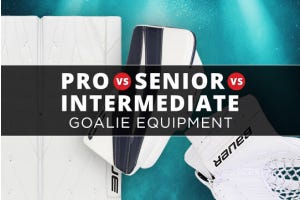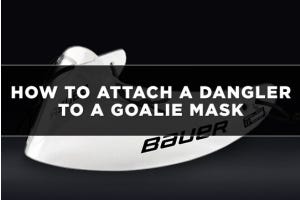How to Wash Hockey Goalie Gloves

Maintaining clean goalie gloves is crucial for optimal performance on the ice. Clean gloves ensure a better grip on the puck, which is essential for making saves and controlling rebounds effectively. Regular cleaning also helps prolong the lifespan of the gloves by preventing premature wear and tear. Goalies often rely on their equipment to perform at their best, making cleanliness and hygiene essential habits to maintain throughout the hockey season.
Understanding the Goalie Glove Materials
Glove material care is essential to maintain performance and longevity. Different materials, such as leather, synthetic, and hybrid, have their own unique cleaning requirements and pros and cons. Understanding these factors helps goalies choose the right glove material based on their preferences and needs.
| Leather | Synthetic | Hybrid | |
|---|---|---|---|
| Cleaning Requirements | Clean with a leather cleaner and conditioner regularly. | Wipe down with a damp cloth and mild soap after use. | Follow care instructions specific to the materials used. |
| Pros of Material | Excellent grip and feel, particularly when broken in. Durable and can withstand heavy use over time. Natural material that molds to the goalie's hand for a custom fit. | Lightweight and typically more affordable than leather. Requires minimal break-in time, ready to use out of the box. Often more resistant to moisture and easier to maintain. | Combines benefits of both leather and synthetic materials (e.g., grip of leather, durability of synthetic). Offers customization in terms of performance attributes like grip, durability, and comfort. |
| Cons of Material | Requires more maintenance to keep supple and prevent drying out. Initial break-in period can be longer and may feel stiff. Generally more expensive than synthetic materials. | May not offer the same level of grip as leather, especially when wet. Durability may vary depending on the quality of the synthetic materials used. May not provide the same tactile feel as leather. | Care requirements can vary depending on the specific materials used in the hybrid construction. Depending on the construction, may inherit some cons of both leather and synthetic materials. |
Checking Manufacturer Guidelines
Checking Manufacturer Guidelines
Following the manufacturer's care instructions is paramount for maintaining the performance and longevity of goalie gloves. These guidelines are typically found either on a care tag attached to the glove or on the manufacturer's website.
Locating Care Guidelines:
- Check for a care tag inside the glove or look up the specific model on the manufacturer's website for care instructions.
Importance of Adherence:
- Performance Preservation: Proper care helps retain the glove's grip and feel, ensuring optimal performance on the ice.
- Durability: Following care guidelines extends the glove's lifespan by preventing premature wear and tear.
- Hygiene: Proper cleaning methods minimize odor and bacteria buildup, maintaining a comfortable and sanitary environment.
- Warranty Compliance: Some manufacturers require adherence to care instructions to maintain warranty coverage, ensuring repair or replacement eligibility if issues arise.
- Expert Advice: Goalie equipment experts emphasize that each material (leather, synthetic, hybrid) and glove model may have specific care needs to maximize performance and longevity. Neglecting these instructions can lead to diminished performance, premature deterioration, and potentially voiding warranty coverage.
Preparing Goalie Gloves for Washing
Spot Cleaning
Ice and Snow:
Solution: Use a soft brush or cloth to gently remove ice or snow. For any remaining residue, dab with a mild detergent mixed with cold water. Rinse with clean water and air dry.
Blood:
Solution: Immediately rinse the affected area with cold water to prevent setting the stain. Use a mild soap or enzyme-based cleaner and gently rub the stained area. Rinse thoroughly with cold water and air dry.
Sweat and Body Oils:
Solution: Use a mild soap or detergent mixed with cold water. Gently scrub the affected area with a soft brush or cloth. Rinse thoroughly with clean water and air dry.
Ink:
Solution: Dab the ink stain with a cloth soaked in rubbing alcohol or a mild solvent. Blot the stain carefully to avoid spreading. Repeat until the ink is lifted, then rinse with clean water and air dry.
Equipment Marks (e.g., puck marks):
Solution: Magic eraser can be used to remove puck marks from the gloves.
Tips:
- Cold Water: Use cold water for rinsing to prevent setting stains and to maintain glove material integrity.
- Gentle Treatment: Avoid aggressive scrubbing to prevent damage to the glove's material and stitching.
- Air Dry: Always allow the gloves to air dry naturally after cleaning to maintain their shape and performance.
General Goalie Glove Cleaning Steps
Pre-treat Stains
Address stubborn stains like mud, grass, or blood with appropriate cleaners before proceeding to the overall wash.
Prepare Cleaning Solution
Mix a small amount of mild soap or detergent with cold water in a basin or bathtub. Ensure the soap is thoroughly dissolved.
Spot Cleaning
Use a soft cloth or sponge dipped in the cleaning solution to gently scrub specific areas of the gloves where stains are concentrated. Avoid aggressive scrubbing to prevent damaging the glove's
material.
Interior Cleaning
Turn the gloves inside out if possible to clean the interior lining. Gently wipe the inside with a damp cloth or sponge dipped in the cleaning solution. Pay attention to areas that accumulate
sweat and oils.
Bathtub Cleaning (Optional for Deep Cleaning)
- Fill a bathtub with enough cold water to submerge the gloves completely. Add a small amount of mild detergent or specialized goalie glove cleaner to the water.
- Immerse the gloves fully in the bathtub and gently agitate them to allow the soapy water to penetrate the material.
- Let the gloves soak for 15-30 minutes to loosen dirt and stains.
Rinse Thoroughly
After cleaning, rinse the gloves thoroughly with cold water to remove all soap residues. Ensure all cleaning solution is washed out to prevent any irritation or damage to your hands during use.
Additional Tips:
- Frequency: Clean goalie gloves regularly, especially after intense use or if they become noticeably dirty or odorous.
- Avoid Heat: Never use hot water or machine dry goalie gloves as it can damage the materials and affect their performance.
- Storage: Store gloves in a cool, dry place when not in use to prevent mold or mildew growth.
To break in your glove in the best way possible, please check out How to Break in Hockey Goalie Glove.
Goalie Glove Drying Techniques
Air Drying
Steps:
- Shake Off Excess Water: After rinsing your gloves, gently shake them to remove as much excess water as possible.
- Blot Dry: Use a clean towel to blot the gloves and absorb additional moisture. Avoid wringing out the gloves as this can damage the material.
- Positioning: Place the gloves in a well-ventilated area. Lay them flat on a dry towel or hang them using clips or a drying rack. Ensure they are spread open to allow maximum air circulation.
- Shape Maintenance: While the gloves are drying, reshape them periodically to maintain their form and fit.
- Patience: Allow sufficient time for the gloves to dry completely. This can take 24-48 hours depending on the humidity and airflow in the drying area.
- Visual Image Recommendations: Step by step image of drying the goalie glove
Avoiding Heat Damage
Key Points:
- No Direct Heat: Avoid placing gloves near direct heat sources such as radiators, heaters, or in direct sunlight. Excessive heat can cause the materials to dry out, crack, or become brittle.
- No Tumble Drying: Never use a clothes dryer for your gloves. The intense heat and tumbling action can deform and damage the materials.
- Fan Assistance: If you need to speed up the drying process, use a fan to increase airflow around the gloves. This helps to dry them more quickly without exposing them to damaging heat.
- Avoid Sun Exposure: Avoid leaving equipment to dry in the sun. This could lead to heat damage and create further glove deterioration. It could dry the glove out completely.
- Drying Inserts: Consider using drying inserts designed for sports equipment. These can be placed inside the gloves to help absorb moisture and maintain their shape.
Goalie Glove Post-Cleaning Inspection
Checking for Damage
1. Visual Inspection
- Examine the Exterior: Look for any visible signs of wear, such as frayed stitching, cracks, or tears in the glove's material.
- Check for Discoloration: Note any unusual discoloration, which can indicate damage or areas where the material has weakened.
2. Flexibility and Padding Check
- Test Flexibility: Gently bend and flex the gloves to ensure they retain their shape and flexibility. Stiff areas can indicate drying or material fatigue.
- Assess Padding: Press on the padded areas to check for even distribution and firmness. Flattened or uneven padding can reduce protection and performance.
3. Stitching and Seams
- Inspect Seams: Closely examine all seams and stitching for any loose threads or gaps. Intact stitching is crucial for the glove's integrity and longevity.
- Tug Test: Gently tug on seams to ensure they are securely attached and not prone to coming apart.
4. Palm and Finger Areas
- Check Palms: Inspect the palm area for signs of wear, such as thinning material or small holes, which can affect grip and control.
- Finger Inspection: Look at the finger areas for any splits or fraying, which can compromise the glove's effectiveness.
Maintenance Tips for Longevity of Your Goalie Gloves
Regular Cleaning Schedule
A routine cleaning schedule for goalie gloves should involve a thorough cleaning every 2-3 weeks, with spot cleaning as needed after each game or practice. Recognize signs that gloves need cleaning by looking for visible dirt, stains, or unpleasant odors, and feeling for any stiffness or reduced flexibility in the material.
Storing Properly
Store goalie gloves in a cool, dry place between games to prevent moisture buildup and odor. Use a glove drying rack or insert breathable glove forms to help maintain their shape and ensure proper ventilation. Additionally, consider using an antibacterial spray or deodorizer specifically designed for sports equipment to keep the gloves fresh and free of bacteria. Avoid leaving gloves in enclosed spaces like bags for extended periods to prevent mold and mildew growth.
To find the best glove for your game, please check out Best Goalie Gloves.
How to Wash Goalie Gloves for Hockey FAQs
How often should I wash my goalie gloves?
It's recommended to wash your goalie gloves every 2-3 weeks to keep them clean and free of bacteria. Spot clean them as needed after each game or practice to maintain hygiene.
Can I machine wash my goalie gloves?
Generally, it's not advised to machine wash goalie gloves as it can damage the materials and padding. Instead, hand wash them using a mild soap and cold water for better care and longevity.
Can I speed up the drying process with a hair dryer or heater?
No, using a hairdryer or heater can damage the gloves by causing the materials to become brittle and crack. Allow them to air dry naturally in a well-ventilated area to maintain their integrity.
Can I use fabric softener on goalie gloves?
It's not recommended to use fabric softener on goalie gloves as it can leave a residue that affects their performance and grip. Stick to mild soap and water for cleaning.









Login and Registration Form
or
Create an account